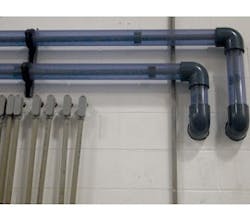Ensuring safe conveyance of hazardous liquids is a critical concern to process manufacturers in many industries. Malfunctioning, broken or unreliable equipment does not only lead to costly repairs and replacements, but also can create unsafe work environments. When that happens, environmental compliance issues and possible fines also become a concern.
Paper manufacturing is recognized as an extremely harsh application for any piping system. In this industry, manufacturers convey sodium hypochlorite (NaOCl), or bleach to whiten raw paper through piping systems. This highly corrosive chemical builds up in steel pipe, eating through it and causing leaks. The result is a costly, unsafe problem.
Thermoplastic Piping System
When one paper manufacturer experienced leaks caused by corroded welds in its stainless steel Sch 40 316L piping system, it looked for a better solution for handling NaOCl in its manufacturing processes. They found that solution with the Double-See double containment corrosive waste piping system in PVC/CPVC from GF Piping Systems. The thermoplastic piping system has effective chemical and corrosion resistance to prevent corrosive build-up. Its double containment design improves safety by eliminating employees’ interacting with chemicals and prevents corrosive liquids from discharging into waste streams. If a leak from the primary pipeline does occur, the fluid is safely contained by the secondary pipe. The pressure-rated system offers ASME B31.3 installation compliance as well as a simultaneous joining design.
The Double-See met the paper manufacturer’s requirements for safer chemical transport, as well as the need to withstand the harsh plant environment. With the use of Harvel EnviroKing clear ultraviolet (UV)-resistant PVC piping as the containment pipe, operators can visually inspect all joint connections for leaks. Additionally, the system’s UV-resistant characteristics make it attractive.
System installation at the paper plant began in March 2013. The system transports the NaOCl from a secure storage facility at about 50 psi. From there, the chemical is pumped up and outside, into the factory where it is delivered to treat raw paper. In some cases, the NaOCl is pumped more than 1,500 ft from the storage facility to be injected in the paper pulp as it is processed. During the process, NaOCl is exposed to a wide range of temperature elements, from summer heat to winter cold.
The Double-See system allows both primary and secondary pipe to be cut to the same length and joined simultaneously. This saves significant installation time and prevents potential mistakes caused by pipe cut measurement errors when using staggered pipe.
Versatile Installation Options
The system yielded good results for the paper manufacturer: No leaks or other issues have occurred on any of the lines. Careful diligence in following factory installation training procedures made installation easy and minimized typical installation issues. With the success of the first installation in four separate projects, the company now is planning 10 more projects to retrofit the entire NaOCl system site-wide.
The piping system offers versatile installation options, assembled and tested fittings, and a pipe cut length guidance system that provides a simplified approach to installation. The system is available with a complete selection of pipe, fittings, leak detection and access tees, closure couplings, and termination fittings. The system also features a patented closure coupling design that allows conformance to ASME B31.3 test inspection requirement and a unique 3D thermal expansion compensation.
In addition to providing the obvious benefits for safe transport of hazardous liquids, the containment system fulfills local, state and federal environmental and safety regulations. It is suitable for many applications, including water and wastewater treatment, chemical delivery, dosing and processing, microelectronics, life sciences, metal working/finishing, waste collection, and many others.
Download: Here


